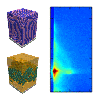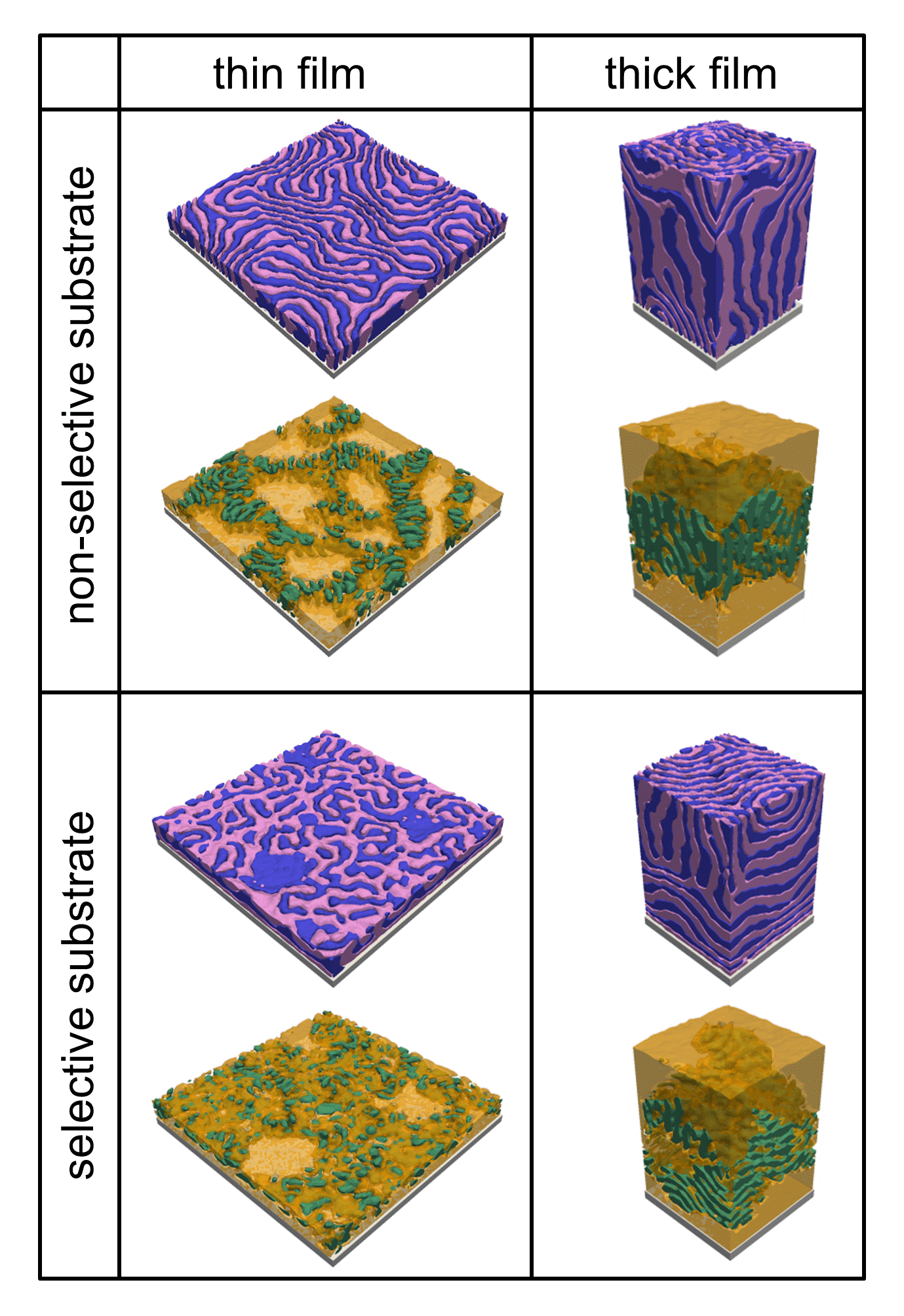X-RAY RUNS: Apply for Beamtime
2017 Nov 1 - Dec 21
2018 Feb 7 - Apr 3
2018 Proposal/BTR deadline: 12/1/17
2018 Apr 11 - Jun 4
2018 Proposal/BTR deadline: 2/1/18

In a Forum Article, which was recently published online in the journal “ACS Applied Materials & Interfaces” [1], Anatoly V. Berezkin and coworkers attempted to figure out what happens when you prepare thin films from two homologous diblock copolymers differing only in overall length. Which structures are they going to form and how will they be oriented? Would mixing allow a finetuning of the thin film structures for special applications, e.g. in nanolithography, without resorting to substrate prestructuring? The team investigated blends of long and short PS-b-P2VP (polystyrene-b-Poly(2-vinylpyridine) with a length ratio of short to long chains of 1:6.9. Each of these polymers microphase separate into lamellar structures by itself, albeit with different period. Blends should feature coexisting domains of thin and thick AB lamellae [2,3]. The question is, in which way such complex structures would be accommodated in thin films on a substrate. Would the films contain domains featuring thin and thick lamellae arranged next to each other within the film plane or would different lamellae be stacked along the film normal? In which direction would the lamellae orient and would these orientations be coupled?
Computer simulations using dissipative particle dynamics (DPD) were performed by Anatoly Berezkin using the supercomputer at Moscow State University, in order to test the influence of the film thickness and the substrate selectivity on the structures of the diblock copolymer blend films and to help interpreting the x-ray scattering results. Simulations were carried out using a computation box containing the polymer film in the bottom and gas above. The polymer film was modeled by short and long diblock copolymers A-b-B as having 2 or 14 beads per block, respectively. The gas was chosen such as to keep the film intact, and it was non-selective to A and B beads. In each case, results from three different, randomly chosen starting configurations were used. The simulations revealed that the film thickness has a strong effect on the structure of films which feature domains from thin and from thick lamellae.
Figure 1 shows the results from a thin and a thick film on a non-selective and a selective substrate, respectively. On a non-selective substrate, the thin film features domains within the film plane which are rich in short and in long copolymers. In contrast, in thick films on a non-selective substrate, these domains are stacked along the film normal, i.e. the core of the film is rich in long copolymers whereas the surface-near layers are rich in short copolymers. The lamellae in the core of the film are standing, which is of interest for a number of purposes, such as nanolithography. Since real substrates, such as the typically used Si wafers, are usually selective to one of the blocks, simulations were also carried out for this case. Under these conditions, the lamellae near the substrate are lying down; however, the thick lamellae in the film core remain standing, i.e. the lamellar orientations are still decoupled. Overall, the selectivity of the substrate favors phase separation of the blends in the vertical direction, i.e. stacked domains.
 Figure 1: Snapshots from computer simulations for films from a mixture of short and long A-b-B diblock copolymers. In all films, the volume fraction of short copolymers, ΦS, amounts to 2/3. Examples for a thin and a thick film are shown for a substrate (grey) which is not selective to any of the blocks and for a substrate which is selective to the B blocks. In each entry, the upper image shows the distribution of the A and the B blocks (blue and magenta, respectively), whereas the bottom image shows the distribution of short and long copolymers (yellow and green, respectively).
Figure 1: Snapshots from computer simulations for films from a mixture of short and long A-b-B diblock copolymers. In all films, the volume fraction of short copolymers, ΦS, amounts to 2/3. Examples for a thin and a thick film are shown for a substrate (grey) which is not selective to any of the blocks and for a substrate which is selective to the B blocks. In each entry, the upper image shows the distribution of the A and the B blocks (blue and magenta, respectively), whereas the bottom image shows the distribution of short and long copolymers (yellow and green, respectively).
Grazing-incidence small-angle X-ray scattering (GISAXS) experiments were carried out at CHESS D-line as part of a long-time collaboration between professor Christine M. Papadakis (Technical University of Munich (TUM), Germany), professor Dorthe Posselt (Roskilde University, Denmark), professor Igor I. Potemkin (Moscow State University, Russia) and CHESS staff scientist Detlef Smilgies. The blend experiments were performed by Anatoly V. Berezkin, a TUM postdoc, and TUM master student Florian Jung together with Dorthe Posselt and Detlef Smilgies. The beamline was configured for GISAXS with a sample to detector distance of 1845 mm for 10.6 keV x-rays. The incident angle was chosen between the critical angles of the polymer film and the substrate (0.12 deg and 0.17 deg, respectively), which allows to obtain structural information from the entire film. Films were prepared from mixtures of symmetric (i.e. lamellae-forming) PS-b-P2VP diblock copolymers using different mixing ratios. Blend films of about 100 nm thickness were obtained by spin-coating solutions onto Si substrates to obtain about 100nm thick films. To achieve equilibrium, films were solvent-vapor annealed in a closed chamber before the GISAXS experiments.
The effect of the film composition on the phase separation was investigated. The GISAXS maps show diffuse Bragg sheets, due to lying lamellae, along with Bragg rods, due to standing lamellae, for a range of compositions ΦS = 0.24…0.70. From the positions of the diffuse Bragg sheets and rods in this composition range, we determine lamellar thicknesses of 33.1 nm and 14.3 nm for the standing and lying lamellae. At the film surface, no regular structure was found, neither from GISAXS in evanescent wave conditions nor from atomic force microscopy, in accordance with simulations.
 Figure 2: (a) GISAXS maps of solvent annealed films from mixtures of PS-b-P2VP diblock copolymers with different fractions ΦS of short-chain block copolymer (values given at the top). The film thicknesses were ca. 100 nm.
Figure 2: (a) GISAXS maps of solvent annealed films from mixtures of PS-b-P2VP diblock copolymers with different fractions ΦS of short-chain block copolymer (values given at the top). The film thicknesses were ca. 100 nm.
For ΦS < 0.24, short and long diblock copolymers do not phase-separate into domains, in qualitative accordance with previous observations in the bulk [2,3]. However, the region where phase separation occurs is narrower in thin film geometry than in the bulk. In the thin films, the commonly formed lamellae are randomly oriented, as evident from the Debye-Scherrer-like rings of high intensity (Figure 2). However, the lamellar thickness depends on the orientation of the lamellar domain: The lying lamellae, presumably located near the substrate, are thinner than the standing ones, presumably located in the core of the film. The results yield a good consistency between simulation and experiment. Thin films of diblock copolymer blends show a complex behavior as function of the mixing ratio, film thickness, and substrate selectivity that could possibly be utilized in technical applications. For instance, the standing lamellar orientation — of interest for nanolithography — can be generated just by admixing a certain amount of short diblock copolymers.
References:
[1] A. V. Berezkin, F. Jung, D. Posselt, D. M. Smilgies, and C. M. Papadakis: "Vertical vs. Lateral Macrophase Separation in Thin Films of Block Copolymer Mixtures: Computer Simulations and GISAXS Experiments", ACS Appl. Mater. Interf. (2017). DOI: 10.1021/acsami.6b16563.
[2] M. W. Matsen: "Immiscibility of Large and Small Symmetric Diblock Copolymers", J. Chem. Phys. 103, 3268-3271 (1995).
[3] C. M. Papadakis, K. Mortensen, D. Posselt: "Phase Behavior of Binary Blends of Symmetric Polystyrene-Polybutadiene Diblock Copolymers Studied using SANS", Eur. Phys. J. B 3, 325-332 (1998).
Submitted by: Christine M. Papadakis, Dorthe Posselt, and Detlef Smilgies
05/05/2017
